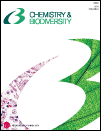
CHEMISTRY & BIODIVERSITY
Scope & Guideline
Advancing Understandings of Chemical Diversity.
Introduction
Aims and Scopes
- Natural Product Chemistry:
The journal publishes studies on the extraction, characterization, and biological activities of chemical compounds derived from plants, fungi, and other organisms. - Pharmacological Studies:
Research that examines the therapeutic effects of natural compounds, including their mechanisms of action against various diseases, particularly cancers and infectious diseases. - Chemical Ecology:
Papers that investigate the chemical interactions between organisms and their environment, including allelopathy, plant-insect interactions, and microbial ecology. - Synthesis and Modification of Natural Compounds:
This includes studies on the synthesis of derivatives of natural compounds and their evaluation for enhanced biological activity. - Analytical Techniques in Chemistry:
Research utilizing advanced analytical methods like LC-MS, GC-MS, and NMR to profile chemical constituents and assess their biological properties. - Environmental Chemistry:
The journal also addresses the chemical aspects of biodiversity, including studies on pollutants, bioremediation, and the chemical composition of environmental samples.
Trending and Emerging
- Bioinformatics and Computational Studies:
There is a rising trend in utilizing computational approaches, including molecular docking and dynamics simulations, to predict the biological activities of natural compounds and their interactions with targets. - Natural Product-Based Drug Development:
Increased focus on the development of new pharmaceuticals derived from natural products, particularly in the context of drug resistance and emerging infectious diseases. - Sustainable Chemistry:
Research that emphasizes sustainable practices in the extraction and synthesis of natural products, aligning with global efforts towards sustainability and environmental responsibility. - Nanotechnology in Natural Products:
Emerging studies on the application of nanotechnology for enhancing the delivery and efficacy of bioactive compounds derived from natural sources. - Metabolomics:
The application of metabolomics to understand the biochemical pathways and interactions of natural products is gaining momentum, allowing for a holistic view of their effects. - Plant-Microbe Interactions:
Increasing interest in the chemical ecology of plant-microbe interactions, particularly how these relationships can lead to the discovery of new bioactive compounds.
Declining or Waning
- Traditional Medicinal Uses:
Research focused specifically on traditional uses of plants has seen a decline, as the emphasis shifts towards more quantitative analyses and mechanistic studies. - Single Component Studies:
There is a noticeable reduction in studies that focus on the pharmacological effects of isolated compounds without considering their interactions within complex biological systems. - General Reviews:
The journal has seen fewer general reviews summarizing broad themes in natural product chemistry, with a trend towards more specific, detailed investigations. - Chemical Synthesis of Non-Natural Compounds:
Interest in the synthesis of entirely synthetic analogs without a direct link to natural products has waned, as researchers focus on modifications of naturally occurring compounds. - Local Flora Studies:
Research specifically targeting the chemistry of local flora in isolated geographic areas has decreased, as there is a growing interest in global biodiversity and comparative studies.
Similar Journals
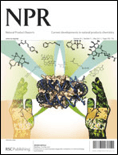
NATURAL PRODUCT REPORTS
Empowering Researchers with Premier Natural Product InsightsNATURAL PRODUCT REPORTS, published by the Royal Society of Chemistry, is a premier interdisciplinary journal that specializes in the field of natural product chemistry. With an impressive impact reflected in its 2023 quartile rankings, it holds a Q1 status in key categories including Biochemistry, Drug Discovery, and Organic Chemistry, highlighting its significance and influence in these areas. The journal, which has been disseminating groundbreaking research since its inception in 1984, serves as a vital resource for researchers, professionals, and students dedicated to advancing the understanding and application of natural products in various scientific contexts. Although it does not offer open access, the journal provides a plethora of insightful reviews and seminal articles that contribute to the collective knowledge and innovation within the natural product community. With a commitment to excellence, NATURAL PRODUCT REPORTS continues to foster collaboration and inspire future breakthroughs in the field.

Natural Products and Bioprospecting
Unlocking Nature's Potential for Tomorrow's SolutionsNatural Products and Bioprospecting is a prestigious academic journal published by SPRINGERNATURE, dedicated to advancing research in the fields of analytical chemistry, biochemistry, plant science, organic chemistry, and pharmacology. With an impact factor that positions it within the top quartiles across multiple categories, this journal serves as a crucial platform for disseminating groundbreaking findings and innovative methodologies focusing on the potential of natural products. Since adopting its Open Access model in 2011, it has broadened its reach, allowing global accessibility to cutting-edge research. The journal, based in Singapore, aims to foster interdisciplinary collaboration and encourages submissions that explore the intricate relationships between natural products and their applications in food science, toxicology, and pharmacology. Its well-respected status is further highlighted by impressive Scopus ranks and a growing H-index, reinforcing its significance in the scientific community. Researchers, professionals, and students alike can benefit from the rich repository of knowledge that Natural Products and Bioprospecting continuously curates and disseminates, making it an invaluable resource in the quest for innovative solutions derived from nature.

RUSSIAN JOURNAL OF BIOORGANIC CHEMISTRY
Connecting Organic Chemistry with Biological BreakthroughsRussian Journal of Bioorganic Chemistry (ISSN: 1068-1620, E-ISSN: 1608-330X), published by MAIK Nauka/Interperiodica/Springer, serves as a vital resource for researchers and professionals in the fields of bioorganic chemistry, biochemistry, and organic chemistry. With a focus on the integration of organic chemistry principles with biological processes, this journal aims to disseminate significant findings and advancements from both theoretical and practical perspectives. Although currently not open access, the journal retains a dedication to high-quality, peer-reviewed content, contributing to its reputation within the academic community. The 2023 Scopus rankings position it within the Q4 category for both biochemistry and organic chemistry, indicating its critical niche within these disciplines amid a competitive landscape. Since its inception in 1996, the journal has continued to evolve, providing enriching insights and fostering collaborations among scholars and practitioners alike, with publication converging up to the year 2024. By exploring complex biomolecular interactions and the synthesis of biologically relevant compounds, the Russian Journal of Bioorganic Chemistry remains a significant platform for advancing knowledge and innovation in the life sciences.
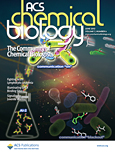
ACS Chemical Biology
Exploring the Molecular Foundations of LifeACS Chemical Biology is a premier journal published by the American Chemical Society, dedicated to advancing the understanding of the chemical underpinnings of biological systems. With an ISSN of 1554-8929 and a distinguished track record since its inception in 2006, this journal provides a vital platform for the dissemination of high-quality research in the realms of biochemistry and molecular medicine, achieving a prestigious Q1 ranking in these categories as of 2023. In an era where interdisciplinary approaches are crucial, ACS Chemical Biology fosters collaboration among chemists and biologists, reflecting a steadfast commitment to exploring the chemical processes that govern life. Although it does not operate under an open-access model, the journal maintains a rigorous peer-review process, ensuring the publication of influential studies that shape the future of chemical biology. With an increasing impact factor and a focus on innovative research, ACS Chemical Biology remains an authoritative resource for researchers, professionals, and students eager to engage with cutting-edge findings in this dynamic field.
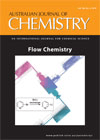
AUSTRALIAN JOURNAL OF CHEMISTRY
Exploring the frontiers of chemistry since 1948.The Australian Journal of Chemistry, with an ISSN of 0004-9425 and an E-ISSN of 1445-0038, is a distinguished publication from CSIRO PUBLISHING, dedicated to advancing the field of chemistry since its inception in 1948. Based in Australia, this journal serves as a platform for original research articles, reviews, and innovative studies that encompass a wide spectrum of chemical disciplines, aiming to foster communication and collaboration among researchers globally. Despite its Q3 ranking in the Chemistry (Miscellaneous) category and standing at rank #236 in Scopus’ general chemistry classification, it remains an essential resource for professionals and students seeking to stay informed about emerging trends and discoveries in chemistry. The journal does not offer open access, emphasizing the premium quality of peer-reviewed content that adheres to rigorous academic standards. By bridging theory and practice, the Australian Journal of Chemistry continues to play a crucial role in shaping the future of chemical sciences.

Moroccan Journal of Chemistry
Advancing Chemistry Knowledge, One Article at a Time.Moroccan Journal of Chemistry, published by the University Mohammed Premier Oujda, serves as a pivotal platform for researchers and professionals in the field of chemistry, particularly focusing on diverse and emerging areas within the discipline. Established in 2018, this open-access journal facilitates widespread dissemination of scholarly articles, ensuring that cutting-edge research reaches a global audience. With an ISSN of 2351-812X and categorized in the Q3 quartile for miscellaneous chemistry in 2023, the journal maintains rigorous peer-review standards while fostering an inclusive environment for scientific dialogue. Located in Morocco, it aims to bridge local and international research communities, contributing to the advancement of knowledge in chemistry. As it continues to grow, the Moroccan Journal of Chemistry remains an essential resource for students, educators, and professionals eager to stay abreast of the latest developments in the field.
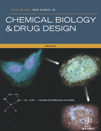
Chemical Biology & Drug Design
Elevating the standards of biochemistry and drug development.Chemical Biology & Drug Design, an esteemed publication by WILEY, serves as a vital platform for the dissemination of pioneering research in the interdisciplinary fields of biochemistry, drug discovery, molecular medicine, organic chemistry, and pharmacology. With a dedicated commitment to advancing the understanding of chemical interactions and drug development, this journal not only fosters innovation but also bridges the gap between theoretical research and practical applications. It boasts an impressive impact factor and is recognized in the 2023 category quartiles as Q3 in Biochemistry and Molecular Medicine, and Q2 in Drug Discovery, Organic Chemistry, and Pharmacology, indicating its relevance and influence in these crucial areas. The journal’s rankings across various Scopus categories further solidify its position as a reputable resource for researchers, professionals, and students striving to stay at the forefront of medicinal chemistry and drug design. While primarily traditional access-based, the journal's evolving scope from 2006 to 2024 ensures an ongoing contribution to essential scientific dialogue, making it an indispensable read for those committed to advancing health sciences.

Acta Chimica Slovaca
Fostering Excellence in Chemical ResearchActa Chimica Slovaca is a prominent peer-reviewed journal dedicated to advancing the field of chemistry, focusing on high-quality research and innovative studies across various chemical disciplines. Published by SCIENDO, this journal aims to provide a platform for researchers, professionals, and students to disseminate their findings, share insights, and foster collaboration in the vibrant scientific community. With an ISSN of 1337-978X and an E-ISSN of 1339-3065, Acta Chimica Slovaca is recognized for its commitment to the integrity and rigor of research publication. Although specific metrics such as H-index and impact factor were not provided, the journal's alignment with international standards and open access principles emphasizes its goal of maximizing the visibility and accessibility of chemical research. Articles published in this journal cover a broad scope, facilitating comprehensive discussions on theoretical, experimental, and applied aspects of chemistry, thus playing a crucial role in the ongoing education and development of the next generation of chemists.

Applied Biological Chemistry
Elevating Scientific Communication in Biochemistry.Applied Biological Chemistry, published by SPRINGER SINGAPORE PTE LTD, is a premier open access journal that has been serving the biological sciences community since 2016. With an ISSN of 2468-0834 and E-ISSN of 2468-0842, this journal is committed to disseminating high-quality research in the fields of Biochemistry, Genetics, Molecular Biology, and Organic Chemistry. The journal holds a commendable position within the scientific community, ranking in the Q2 quartile for both Biochemistry and Organic Chemistry niches as of 2023. It aims to foster innovative research and facilitate discussions that propel the understanding of complex biochemical processes and molecular techniques. By providing open access to its contents, Applied Biological Chemistry ensures that valuable research is readily available to researchers, professionals, and students globally, encouraging collaboration and knowledge sharing in this rapidly evolving discipline. Its pivotal role in enhancing scientific communication in the Netherlands and beyond is further underscored by a steadily increasing impact in the academic arena.

Izvestiya Vuzov-Prikladnaya Khimiya i Biotekhnologiya
Exploring the Intersection of Theory and PracticeIzvestiya Vuzov-Prikladnaya Khimiya i Biotekhnologiya, published by Irkutsk National Research Technical University, is a prominent open-access journal dedicated to advancing the fields of applied chemistry and biotechnology. Since its inception in 2011, this journal has provided a platform for the dissemination of significant research findings, innovative techniques, and technological advancements that bridge the gap between theoretical frameworks and practical applications. The journal is indexed in various databases, ensuring that published works reach a global audience of researchers, professionals, and students eager to explore the latest developments in these critical disciplines. With its commitment to open-access publishing, Izvestiya Vuzov-Prikladnaya Khimiya i Biotekhnologiya plays a vital role in fostering collaboration and knowledge sharing within the scientific community, thus contributing to the advancement of both fields in a rapidly evolving technological landscape.